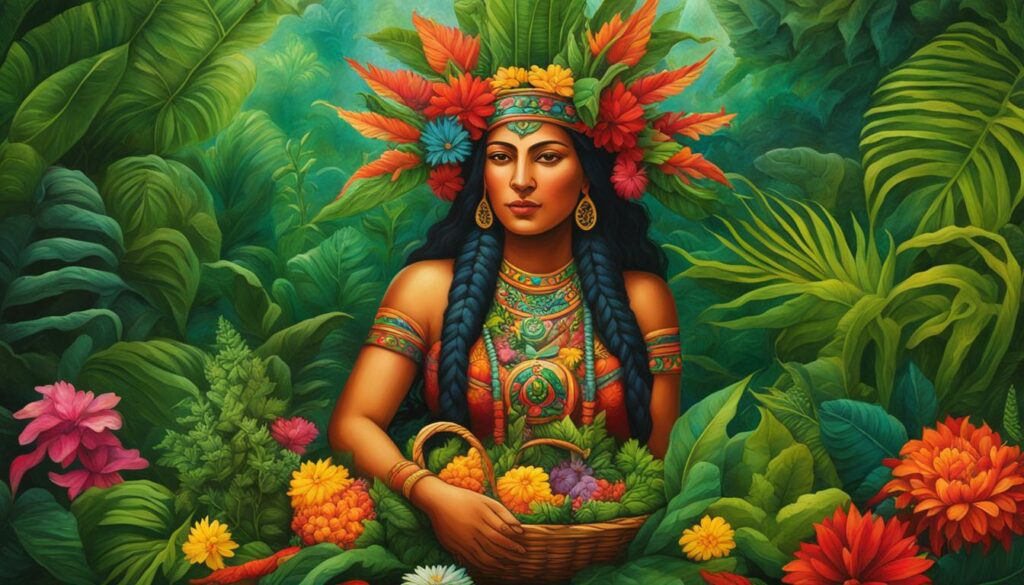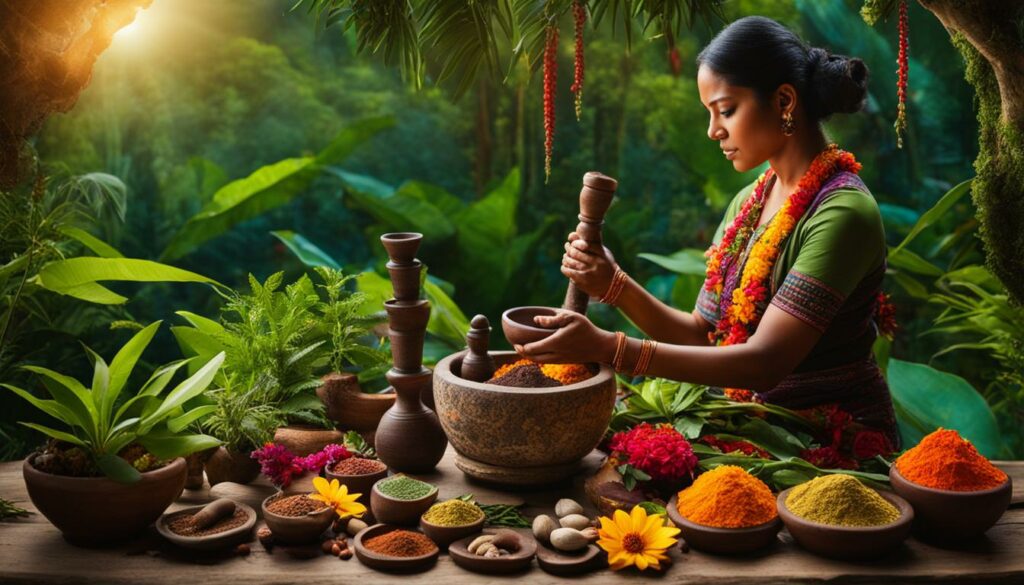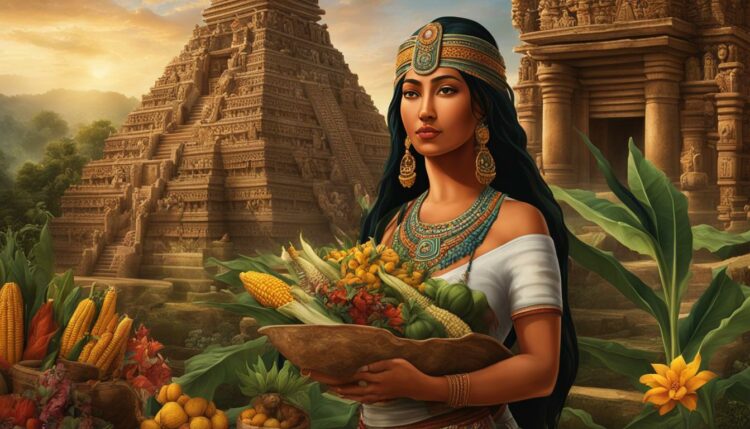The ancient Mayan civilization had a profound understanding of the importance of sexual health and fertility in the perpetuation of their existence.
Their cultural practices and beliefs revolved around the concept of fertility, which they considered sacred and deeply intertwined with their connection to the natural world.
The Mayans valued the harmony between human reproductive concerns and the environment, as reflected in their mythological symbols inspired by elements like earth and water. Their myths and rituals were centered around fertility, reflecting the human desire for reproduction and the continuation of life.
Ancient Mayan sexual health practices encompassed a holistic approach, incorporating natural remedies, traditional healing methods, and indigenous wisdom. These traditional fertility remedies involved a deep understanding of herbalism, medicinal plants, and holistic wellness practices.
Today, ancient Mayan fertility practices continue to interest scholars and researchers, highlighting the potential benefits of integrating traditional wisdom with modern approaches to reproductive health and wellness.
Key Takeaways:
- The Mayan civilization placed significant importance on sexual health and fertility.
- Their cultural practices and beliefs were deeply rooted in the concept of fertility.
- Ancient Mayan fertility practices embraced a holistic approach to wellness.
- Mayan fertility remedies included herbalism, medicinal plants, and traditional healing methods.
- Integrating ancient Mayan wisdom with modern approaches can lead to enhanced reproductive health and wellness.
The Concept of Myth in Ancient Maya Civilization
In the ancient Maya civilization, myth played a vital role in shaping their beliefs, customs, and worldview. Mayan mythology is a rich tapestry of stories and legends that encompassed various aspects of life, including the creation of the world, gods and goddesses, and the origins of humanity.
According to renowned scholar Mircea Eliade, myth was seen as a sacred and divine narrative that explained the fundamental questions of existence. It served as a model that was constantly repeated, reflecting the cyclical nature of time in the Mayan cosmology.
The ancient Mayans, like many other cultures, believed that myths played a crucial role in harmonizing the mind and body, as well as establishing a connection with nature.
These myths were not merely fantastical tales; they were deeply rooted in the Mayan culture and reflected their deep-seated desire to perpetuate life and fertility.
Mayan myths often incorporated symbols of fertility, drawing inspiration from the natural world. The abundance of agricultural fertility was a vital aspect of Mayan society, and their myths reflected the importance of sustaining and nurturing the land.
By understanding the symbolism of fertility, the Mayans sought to ensure the well-being of their communities and the continuity of life.
“Myths are the embodiments of archetypal human experiences, providing profound insights into the human condition and our relationship with the natural world.” – Mircea Eliade
These ancient stories were not viewed as meaningless or absurd; instead, they held significant meaning and contributed to the cultural fabric of the Mayan civilization. Myths were an integral part of ceremonies, rituals, and religious practices, offering a framework for understanding the mysteries of the world.
Understanding the importance of myth in Mayan culture allows us to gain valuable insights into the intricate web of beliefs, rituals, and symbols that shaped their society. It provides a window into how the ancient Mayans perceived fertility, the natural world, and their place within it.

Ancient Mayan Myths and Fertility Symbols
Ancient Mayan myths were replete with symbols of fertility, representing the life-giving forces of the universe. These symbols were not limited to representations of human fertility; they extended to the fertility of the land, crops, and animals.
One significant fertility symbol in Mayan mythology was the Maize God, also known as Hun Hunahpu. The Maize God symbolized the cycle of life, death, and rebirth, mirroring the annual agricultural cycle of sowing, harvesting, and regrowth.
The Maize God’s sacrifice and subsequent resurrection were believed to bring forth bountiful crops and ensure the prosperity of the Mayan people.
Another prominent fertility symbol in Mayan mythology was the Water Lily Jaguar God, associated with rain, water, and fertility. The Water Lily Jaguar God was believed to provide the life-giving rains needed for successful agriculture, contributing to the fertility of the land and the growth of crops.
These fertility symbols served as reminders of the deep connection between the natural world and the well-being of the Mayan people. They encapsulated the profound importance of fertility and the perpetuation of life in Mayan culture.
| Mayan Fertility Symbols | Meaning |
|---|---|
| Maize God | Symbolizes the life, death, and rebirth cycle |
| Water Lily Jaguar God | Associated with rain, water, and agricultural fertility |
The presence of these symbolic representations of fertility in Mayan myths highlights the deep-rooted human desire to understand and celebrate life’s perpetuation. It also emphasizes the Mayan civilization’s reverence and appreciation for the natural world and its fundamental role in sustaining their existence.
Maya Women and Modern Healthcare in Guatemala
This section sheds light on the healthcare challenges faced by Maya women in present-day Guatemala. The country continues to struggle with high rates of maternal and infant mortality, and there are significant disparities in healthcare access between indigenous Maya women and ladino women in the country.
This situation highlights the urgent need to address healthcare disparities and improve reproductive healthcare services for Maya women.
Maya women in Guatemala face numerous hurdles when it comes to accessing modern healthcare services. One of the primary reasons is the lack of availability and awareness of biomedical reproductive services among the Maya population, especially in rural areas.
This limited access is often attributed to cultural differences and inadequate understanding of the benefits and importance of such services.
To truly address the healthcare disparities faced by Maya women, it is crucial to understand and respect their cultural beliefs and integrate culturally acceptable healthcare approaches. This can help build trust and bridge the gap between indigenous communities and modern healthcare systems.
By combining indigenous knowledge and traditional practices with modern healthcare, tailored reproductive healthcare services can be developed to meet the unique needs of Maya women.
Culturally sensitive initiatives that provide education and awareness about fertility services can pave the way for better healthcare outcomes for this marginalized population.
Efforts in Addressing Healthcare Disparities
Several organizations and initiatives are striving to improve healthcare access for Maya women in Guatemala. These efforts focus on empowering indigenous communities and promoting reproductive health and rights. Some key initiatives include:
- Community health programs that prioritize education on reproductive health and family planning methods.
- Training and equipping local midwives to provide culturally appropriate care and safe delivery services in indigenous communities.
- Collaborations between traditional healers and modern healthcare practitioners to integrate traditional knowledge and practices into reproductive healthcare services.
These efforts aim to create a more inclusive and comprehensive healthcare system that addresses the unique needs of Maya women while respecting their cultural heritage.
Case Study: Successful Collaboration in Maya Reproductive Healthcare
An example of successful collaboration in Maya reproductive healthcare is the Partnership for Maternal and Child Health (PAMMCH) in Guatemala. PAMMCH is a non-profit organization that works closely with local communities to provide accessible and culturally sensitive healthcare services.
“We believe that by embracing the traditions and cultural values of Maya communities, we can provide effective and respectful reproductive healthcare services. Our collaborative approach brings together modern medical knowledge and traditional healing practices to address the healthcare disparities faced by Maya women.”
– Maria Lopez, Founder of PAMMCH
PAMMCH’s approach emphasizes community engagement and education while incorporating traditional healing practices. By integrating traditional and modern healthcare, PAMMCH has made significant strides in improving reproductive healthcare outcomes for Maya women in Guatemala.
Overall, addressing the healthcare disparities faced by Maya women requires a multi-faceted approach that encompasses cultural sensitivity, education, and collaboration between indigenous communities and modern healthcare systems.
By recognizing and respecting Maya women’s distinct healthcare needs and incorporating their cultural beliefs, we can work towards achieving equitable and accessible reproductive healthcare for all.
| Key Healthcare Disparities Faced by Maya Women | Efforts to Address Healthcare Disparities |
|---|---|
| High rates of maternal and infant mortality | Community health programs prioritizing reproductive health education |
| Limited access to biomedical reproductive services | Training and equipping local midwives to provide culturally appropriate care |
| Cultural barriers and lack of awareness | Collaborations between traditional healers and modern healthcare practitioners |
Ayurveda and Mayan Fertility Practices
This section explores the holistic approach of Ayurveda in improving fertility, which can be paralleled with Mayan fertility practices. Ayurveda offers natural fertility boosters and remedies that have been used for centuries.
Both men and women can benefit from Ayurvedic treatments, which focus on cleansing the body from toxins, nourishing it with optimal nutrients, and reducing stress levels.
Ayurvedic fertility herbs and lifestyle changes can regulate hormones, improve reproductive health, and increase the chances of pregnancy. The emphasis on reducing stress is crucial, as it is a significant factor in fertility.
Ayurveda offers a comprehensive approach to fertility enhancement, ensuring the mind and body are in an ideal state for procreation.

Ayurveda, an ancient Indian healing system, provides a holistic approach to reproductive health and fertility. Its principles align with the concepts of balance, harmony, and natural healing, similar to Mayan fertility practices.
By incorporating Ayurvedic remedies and lifestyle changes, individuals can optimize their reproductive health and increase their chances of conceiving.
Ayurvedic Fertility Boosters
- Shatavari: This herb is known for its rejuvenating effects on the female reproductive system, balancing hormones, and enhancing fertility.
- Ashwagandha: Considered a powerful adaptogen, ashwagandha helps reduce stress, balance hormones, and improve overall reproductive health.
- Turmeric: Its anti-inflammatory properties promote a healthy uterus and enhance fertility.
- Ginger: Known for its warming properties, ginger stimulates circulation and supports reproductive health.
- Yoga and Meditation: Ayurveda emphasizes the importance of stress reduction through practices like yoga and meditation, which can positively impact hormonal balance and reproductive function.
Mayan Fertility Practices
- Herbal Remedies: Mayans used a variety of herbs to support fertility, including maca root, damiana, and chaste berry.
- Massage and Bodywork: Mayan abdominal massage, known as “Arvigo Techniques of Maya Abdominal Therapy,” aims to promote reproductive health by improving blood circulation and restoring balance to the reproductive organs.
- Rituals and Ceremonies: Mayan fertility rituals focused on connecting with nature, seeking blessings from fertility deities, and invoking divine assistance for conception.
- Diet and Nutrition: Mayans followed a balanced diet rich in fruits, vegetables, and nutrient-dense foods to support reproductive health.
By blending the ancient wisdom of Ayurveda with Mayan fertility practices, individuals can embrace a holistic approach to reproductive wellness. By addressing physical and emotional well-being, reducing stress, and nourishing the body with natural fertility boosters, individuals can enhance their chances of fertility success.
Conclusion
In conclusion, the Mayan civilization’s approach to sexual health and fertility offers a valuable glimpse into ancient wisdom and traditional practices. The Mayans recognized the profound significance of fertility and reproduction in their culture, and their rituals and beliefs reflected this profound understanding.
Today, there is a pressing need to bridge the gap between ancient wisdom and modern healthcare approaches in order to enhance reproductive wellness within indigenous communities.
By integrating traditional practices, such as those found in Ayurveda, with modern healthcare, we can develop holistic and culturally sensitive solutions for fertility concerns.
This combination of ancient wisdom and a modern approach holds immense potential for unlocking the secrets of Mayan sexual health and fertility. It paves the way for optimizing reproductive wellness while honoring the rich heritage of the Mayan civilization.
With a deep appreciation for the Mayan civilization’s reverence for fertility and a commitment to embracing a holistic perspective, we have an opportunity to improve reproductive healthcare and wellness for individuals and communities alike.
By drawing upon the wisdom of the past and leveraging the advancements of the present, we can foster a future where reproductive wellness is prioritized and celebrated, honoring the legacy of the Mayan people and empowering generations to come.
FAQ
What were some of the Mayan fertility practices?
The ancient Mayans had various fertility practices, including rituals, ceremonies, and the use of natural remedies. These practices aimed to enhance fertility and support reproductive health.
What were the symbols of fertility in Mayan mythology?
The Mayans drew inspiration from nature for their fertility symbols. Elements such as earth and water were associated with fertility, and these symbols played a significant role in Mayan mythology.
What are the healthcare challenges faced by Maya women in modern-day Guatemala?
Maya women in Guatemala face significant healthcare challenges, including high rates of maternal and infant mortality. There are also disparities in healthcare access between indigenous Maya women and ladino women.
Why are biomedical reproductive services not widely used among the Maya?
Cultural differences and lack of awareness are some of the reasons why biomedical reproductive services are not widely utilized by the Maya, particularly in rural areas.
How can traditional practices be integrated into modern healthcare to improve reproductive wellness in indigenous communities?
Integrating traditional practices, such as those found in Ayurveda, with modern healthcare approaches can provide holistic and culturally acceptable solutions for fertility issues in indigenous communities.
What does Ayurveda offer in terms of fertility enhancement?
Ayurveda offers natural fertility boosters and remedies that have been used for centuries. It focuses on cleansing the body, nourishing it with optimal nutrients, reducing stress levels, and regulating hormones to improve reproductive health.




